Please note: During this time of uncertainty, we are continuing to post stories on the LTV Blog. In doing this, we hope to give you reasons to smile, and a chance to dream of future adventures. All travel mentioned in these posts took place prior to the COVID-19 pandemic and associated restrictions. We ask our LTV family to follow all recommendations of local health and government authorities regarding travel and social distancing. We are all in this together. You can read our full COVID-19 response here.
There it was, the Mississippi River. Wide and muddy colored, it seemed to move its great bulk of water with no effort. Speed boats skidded across its surface, past the small town of Le Claire, Iowa, that graces the western bank. The Mississippi had always been the western boundary for our travels and we never thought to venture beyond it before we bought an RV. Now, in our Unity, we were about to explore new vacation territory.
By the time we reached the Illinois-Iowa border, we had been traveling for several weeks. The lush green farms and fields of the Midwest were a stark contrast to the bleak cotton fields and peanut farms of our Georgia home. (There are, of course, some who would beg to differ, since a cotton field full of fluffy white bolls is quite a pretty sight.) As we left our campground, we picked up the highway that would lead us to the Mississippi. An early July morning buzzed with katydid song and soon the great river came into view.
One of our favorite television shows, American Pickers, is set in Le Claire, just over the bridge. The shop that we’ve viewed so many times on TV was there for us to explore. Familiar props used in many episodes had us smiling, pointing, and saying, “Remember that one?!” It didn’t matter that the main characters were missing, we just enjoyed walking through the “set” perched on a hill above the Mississippi.
We felt a little like celebrities ourselves when a couple asked about our Unity MB. It happens all the time! We spent the next thirty minutes talking with our new friends and giving them a tour of our unit. We bid them farewell and good luck with their RV purchase. Then it was time to continue our journey west.
Once we had crossed the South Dakota border we felt we were truly in the western territory! The vast grasslands and prairie we traversed from Sioux Falls seemed to stretch from horizon to horizon. Mere smudges of mountains arose in the distance and made us excited to see more. But first, we needed to find a campground and learn more about a drug store that put a small South Dakota town on the map. We pulled into a campground in Wall, South Dakota, across the street from the famous Wall Drug Store.
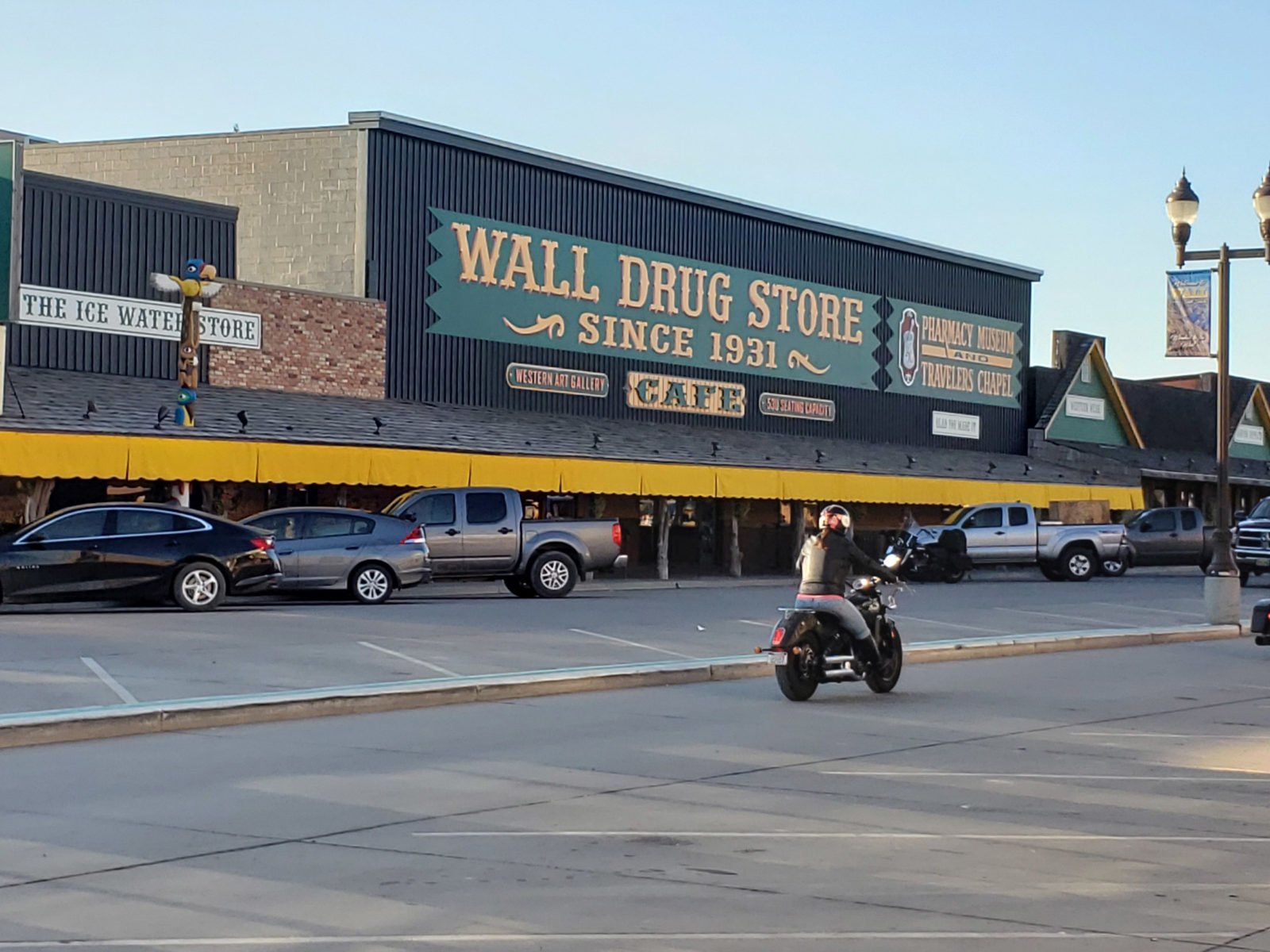
Ted Hustead’s Wall Drug Store has been offering weary travelers free ice water since the 1930s, a suggestion that his wife Dorothy made as a way to lure motorists to stop at the small store. It worked! During long, hot drives across the prairie, travelers welcomed a place to stop, enjoy a cold drink, pick up a few supplies, and then continue on their way. Over the years, Mount Rushmore National Memorial and Badlands National Park would make the small town an oasis for tourists on their way to see the attractions.
The drug store grew to the mega-plex it is today, offering a restaurant, souvenir shop, locally made handicrafts, leather goods, a chapel, and, of course, a drug store. Just about an hour east of Rapid City, South Dakota, it serves its community of 800 residents as well as over 2 million visitors each year. The food is very good, the drug store still sells all the appropriate items, the ice water is still free, and the coffee is just a nickel. Can’t beat that!
The next morning, we headed out to tour Badlands National Park. We chose a back road from town to the closest Park entrance. The dusty road was flanked by rocky terrain and dry grassland prairie, and we wondered if we had made a wrong turn. But finally, in the distance up ahead, we could see the small building that serves as a gate to the Park. The Ranger gave us a map and mentioned the rim road as a good way to view the Park. It was a narrow dirt road but we knew our little Unity could easily navigate the tight space. At the first overlook, we got out and were immediately captivated by the wide-open expanse of the canyons.
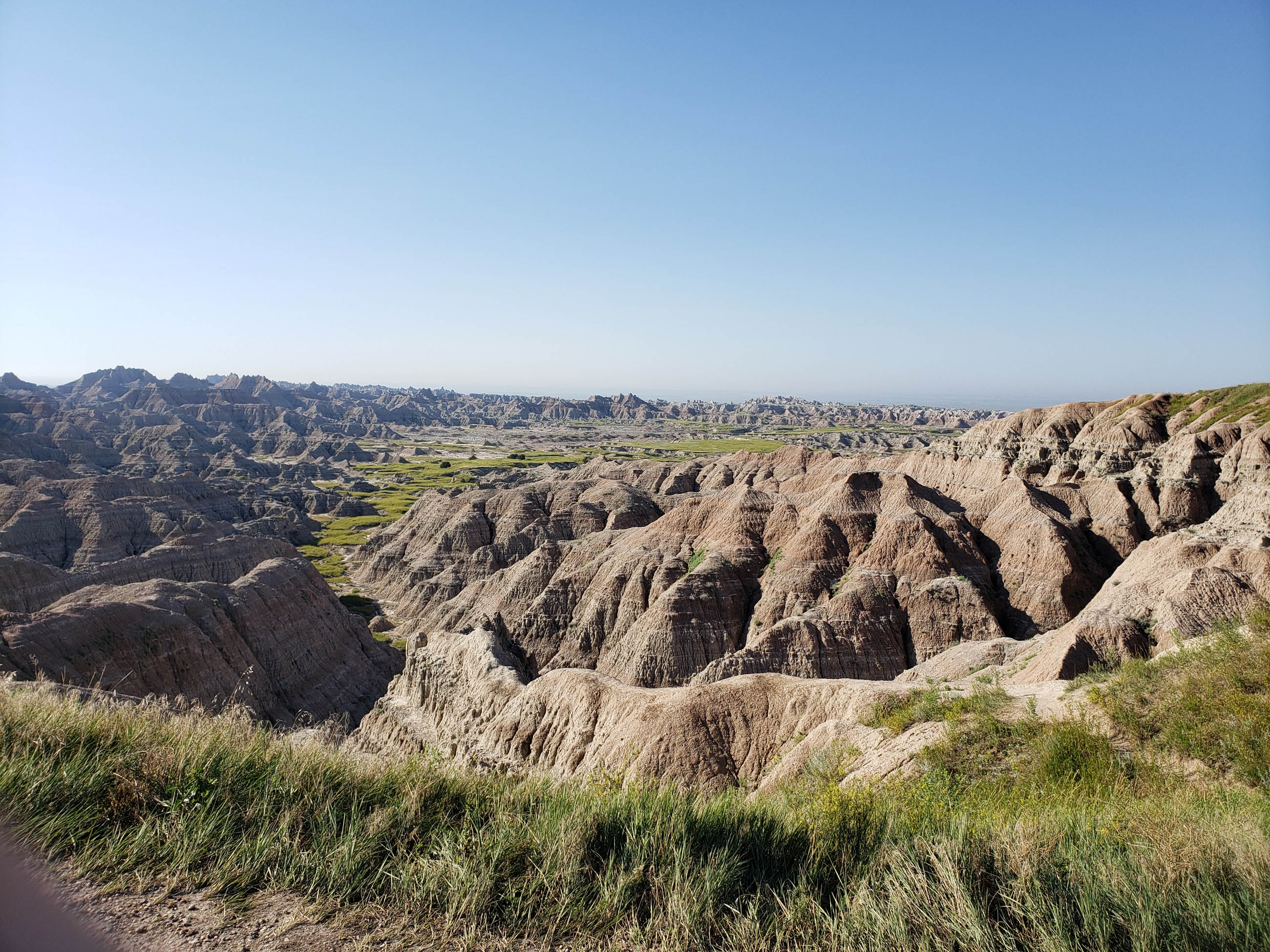
White pinnacles and canyon walls striped with pink and rust made the whole sight seem like a watercolor painting. It was quiet, and the sound of the wind through the scraggly brush on the rim road made a lonely whistling sound, adding power to the stark landscape before us. The early pioneers must have been dumbstruck when they saw this landscape.
The canyon floor is made up of sand and rocky debris, while the hilly areas are clothed in brush. With horses and wagons, there wouldn’t seem to be any reasonable trail through the rocky terrain. Looking at it, I couldn’t imagine how difficult a passage it would have been on horseback – even a hike here would be a challenge. It is very dry, exposed to the sun and wind with little shade available to provide any relief. But the sheer size of the area and the unusual character of the rocks make it almost mesmerizing to view from a distance.
As we stopped to take a few photos at an overlook, a dark spot in the brush next to the driver’s side door seemed to heave. Jim and I stared through the bright sunlight and focused on a buffalo settling in for an afternoon nap. We were warned by the Park Ranger to keep a safe distance from these huge animals. They are surprisingly fast on their feet and, at 2000+ pounds, they can easily do damage to your vehicle. We didn’t disturb him but returned to the RV, took a few photos, and departed as quietly as we could!
Further along the rim road, a sign announced Roberts Prairie Dog Town – yeah! This was an animal I really wanted to see. We parked the RV and watched patiently. Sure enough, heads popped up from dozens of mounds as the agile little animals skittered from place to place. It looked like they were playing tag. The color of their coats blended so well into the surrounding sandy soil that photographing them was almost impossible (I knew I should have bought that zoom lens!). Nonetheless, we enjoyed their busyness as they scampered around their “town.”
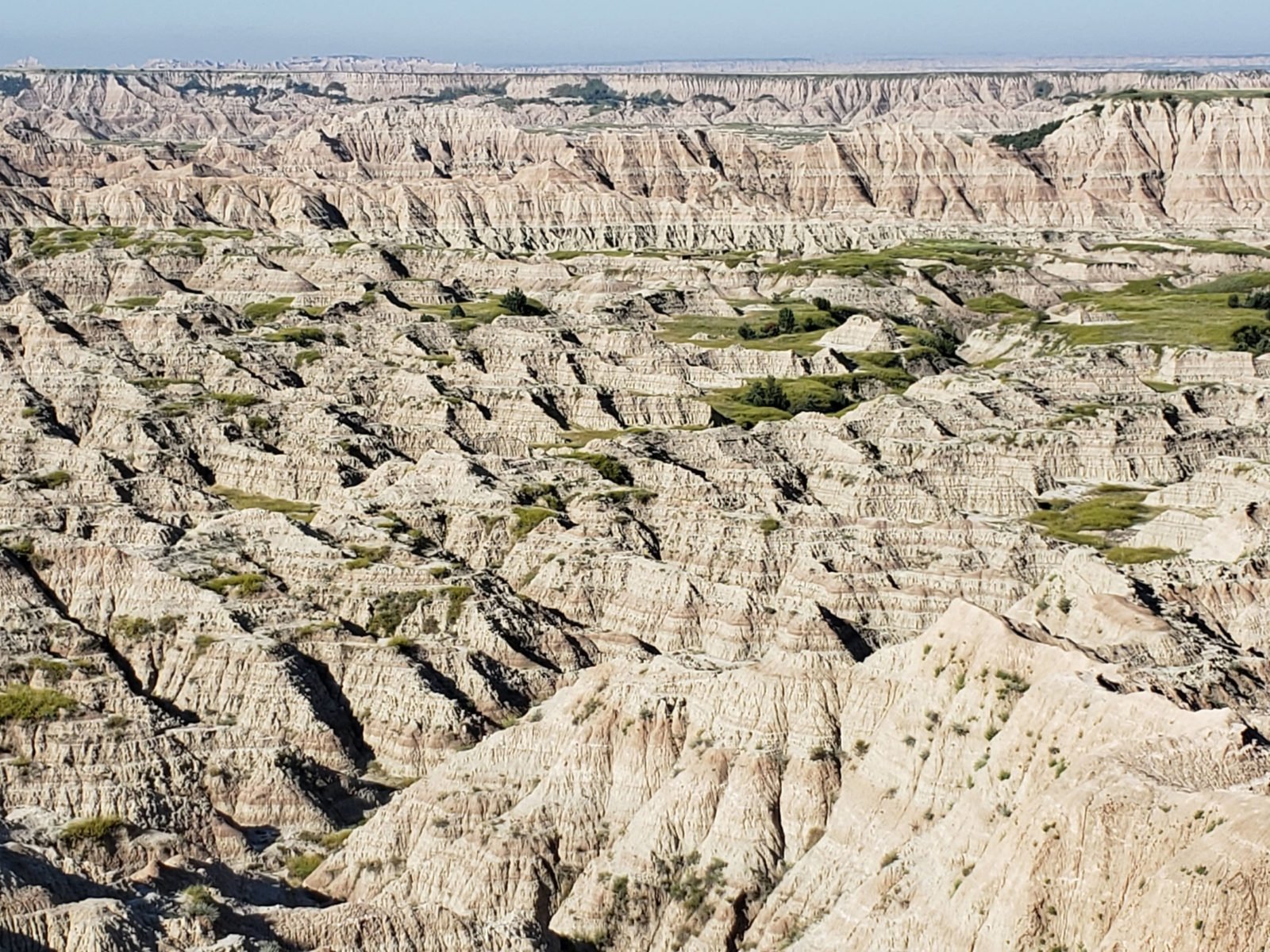
A stop at the visitors center is always on our itinerary when we visit national parks, both to find out more about the park and to learn more about the land. At Ben Reifel Visitor Center we learned more about the geology of the Badlands, how the landscape was formed (and is still being formed), and what the area has yielded in terms of paleontology.
The Badlands are one of the richest fossil beds in the world. Beginning in 1846 with the discovery of an ancient animal mandible, the fossils unearthed over the years range from ancient marine creatures to camels, rhinoceros, turtles, and more. Many fossils from the Badlands are now in museums around the world.
In the Visitor Center we found a lab where paleontologists work to clean fossils gleaned from the Park’s fossil beds. While we looked on, they used dental tools and brushes under high-intensity lights to reveal the bones of small animals who roamed this area millions of years ago. The scientists were happy to answer our questions and tell us about what the fossil beds were yielding today.
Yet it is the land itself that is most endlessly fascinating. A short film on the geology of the Badlands gave us a good overview of what we had spent the day touring. (To enjoy your tour even more, I recommend you see the movie first!) The stark white rock formations are striped with muted pink, gray, and rust. Each color is formed by layers of sand, silt, and clay laid down over the course of 75 million years.
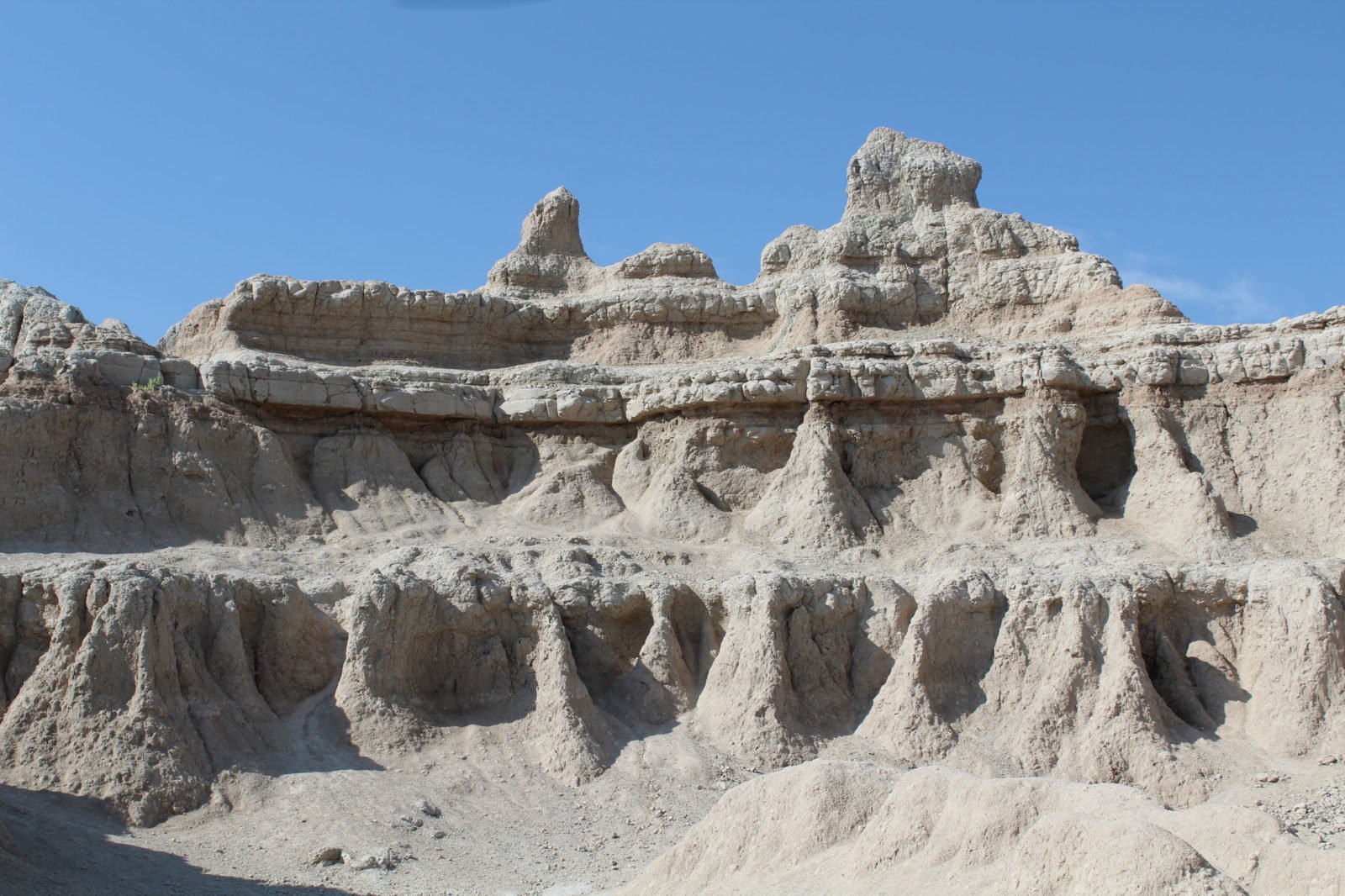
The deposits were originally created by an ancient sea, then river floodplains. The area began to erode when modern rivers carved into the sandstone, aided by wind, snow, and rain. These shaping forces are still at work, wearing away the sandstone at a rate of about one inch per year. What is left now is an amazing variety of pinnacles, spires, and buttes surrounded by vast grassland prairie – one of the largest expanses of grassland prairie in the United States.
The check-in to our campsite was next door to the Visitor Center, inside a gift shop/restaurant run by Cedar Pass Lodge. We picked up a couple of souvenirs and then had a bite to eat before checking into our site at Cedar Pass Campground. The RV campground is located quite near the Visitor Center and just down the road from the gift shop. Most national park campgrounds are tucked away from the main attraction, and we assumed that the Badlands campground would be similarly situated away from the beautiful rock formations.
To our delight, the campground sits on a wide-open space between and among all the formations! Every direction offers views of canyon walls and spires and long-distance views of the prairie. It was truly an unexpected surprise. Each campsite is tucked into the side of the campground loop road and many provide electrical hookups. Although there are no trees for shade, each site has a covered picnic table.
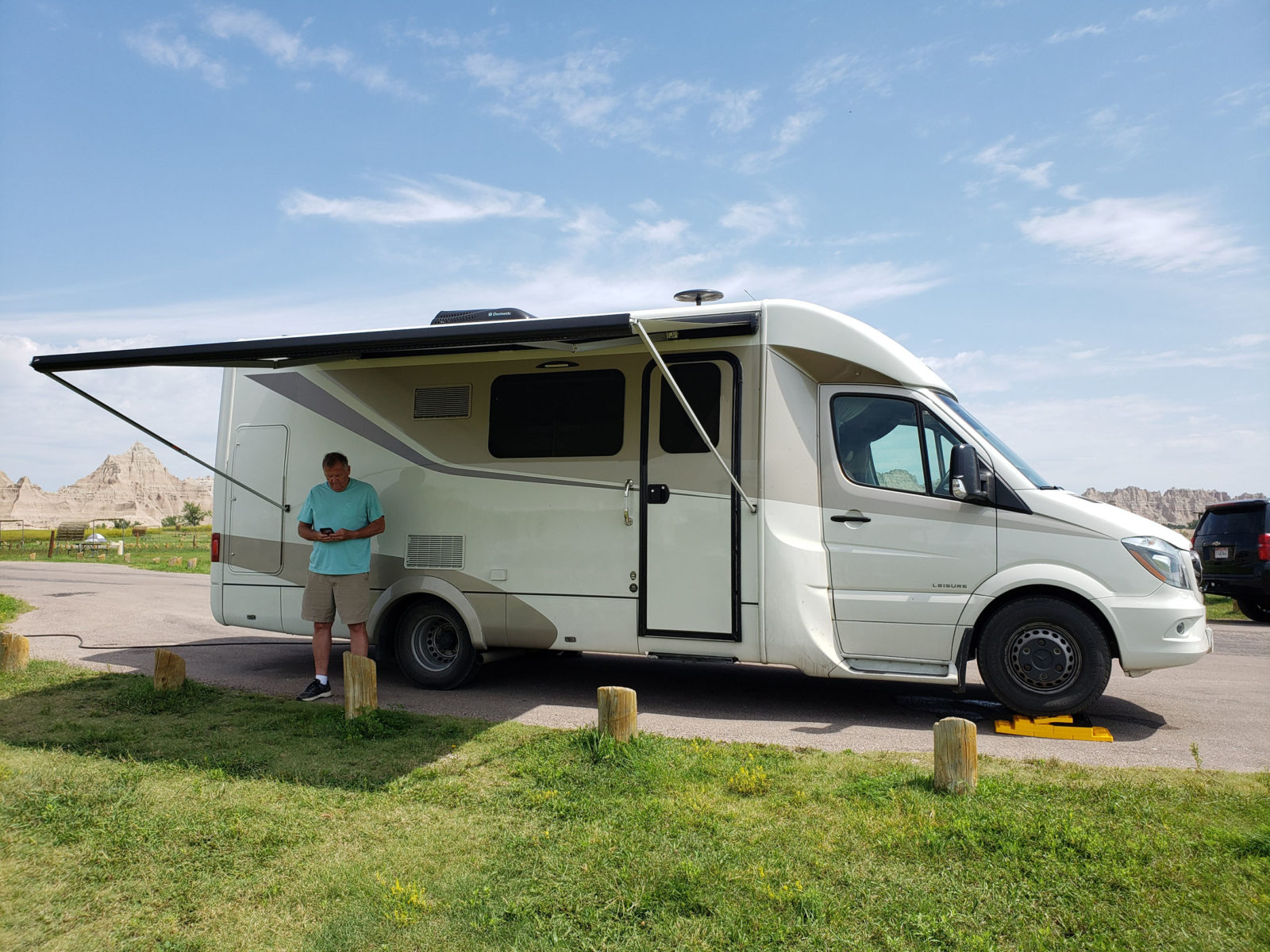
There are no water hookups but there is water available, as well as toilets and a dump station (for a fee of $1.00). The 96 campsites are available from April through October, but check with Cedar Pass Lodge for reservations – it is a very popular campground. The only other campground in the Park is the more primitive Sage Creek Campground.
While hiking and biking are popular activities in the Park, we enjoyed the evening program put on by one of the Park Rangers. As the searing afternoon sun gave way to the cooler evening darkness, a small group of campers gathered at the campground amphitheater. Together we viewed the night sky while the Ranger offered information about what we saw through our telescopes. Absolutely spectacular!
So many stars and so much sky. Even though it was not a super-clear night, we saw billions of stars. Back at home, trees often limit our view of the night sky, and the ambient light from cities and street lights make stargazing a “less-than-stellar” affair. But here, the wide-open spaces, the dark night sky, and the absence of any city lights offered the experience of stepping into the universe. The stars spread out before us from horizon to horizon.
Early the next morning, we took our coffees outside and sat at our picnic table to watch the sun creep into the canyon. The sun seemed to throw spotlights on the taller pinnacles as it rose over the canyon’s edge. The morning air began to warm and we packed up the RV for one last tour of the Park before heading on to our next destination.
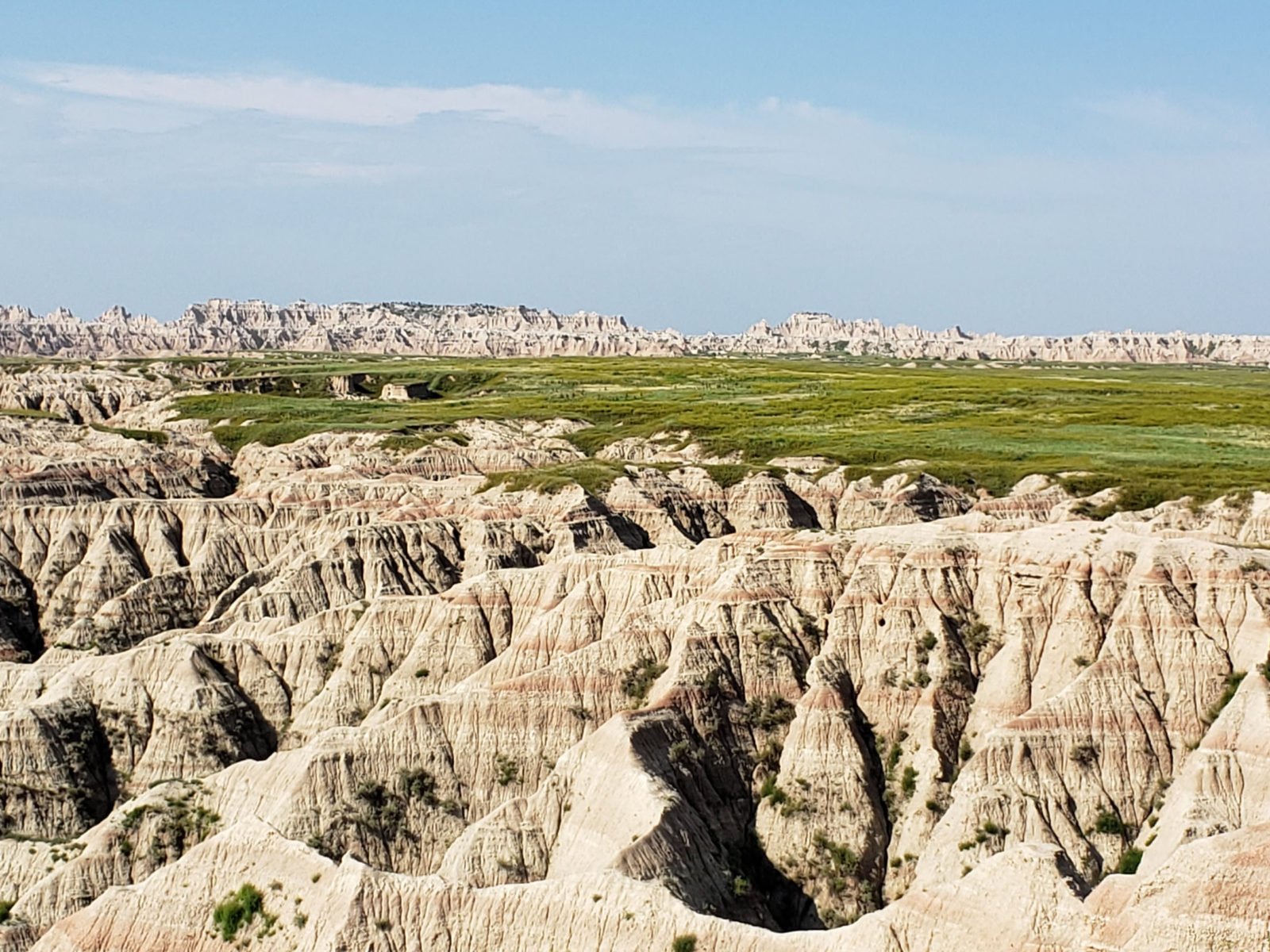
Unlike the dusty rim road, the main road around the Park is paved and makes for an easy drive in an RV. We stopped to enjoy all the small daisy-like flowers along the overlook walkways, so pretty and fragile in such a harsh environment. We had seen buffalo, antelope, jackrabbits, and hawks – all quite wonderful. But there was one Badlands critter we hadn’t imagined until a sign by the walkway warned us of its presence: “Beware of Rattlesnakes In This Area.” Yikes! That made for some very attentive stepping from the overlook to the RV!
As we drove out of the canyon, we stopped to take a few more photos at an overlook. The early morning light created a quiet and ethereal shroud in the canyons. Spires and pinnacles seemed to shimmer against the blue sky. We took hundreds of photos, but we knew it would be impossible to capture the feeling of actually being in this place.


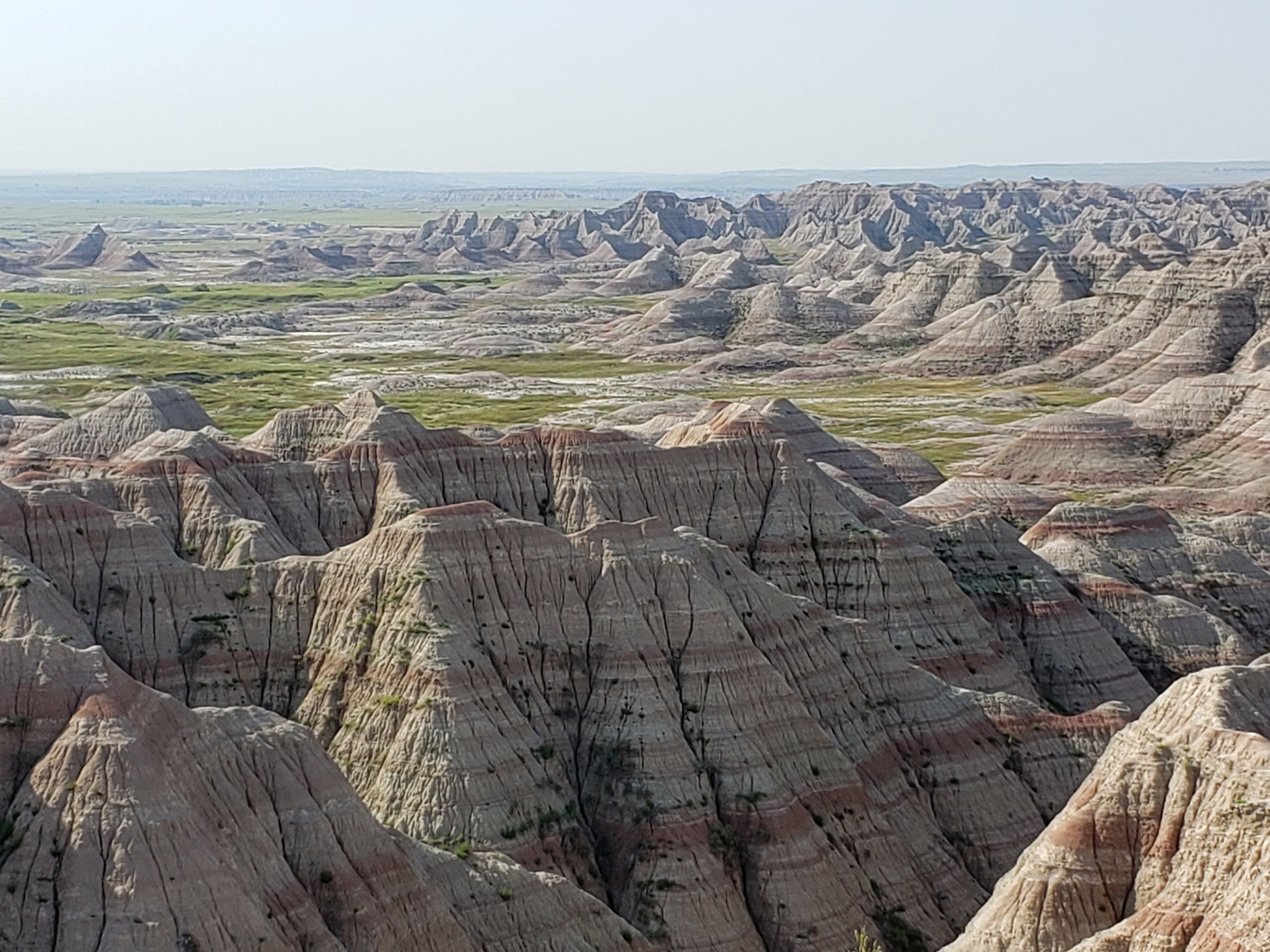


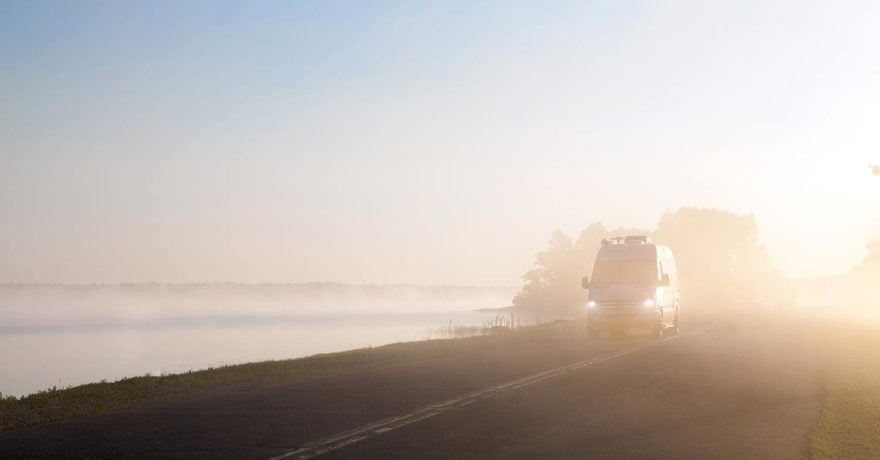
Comments